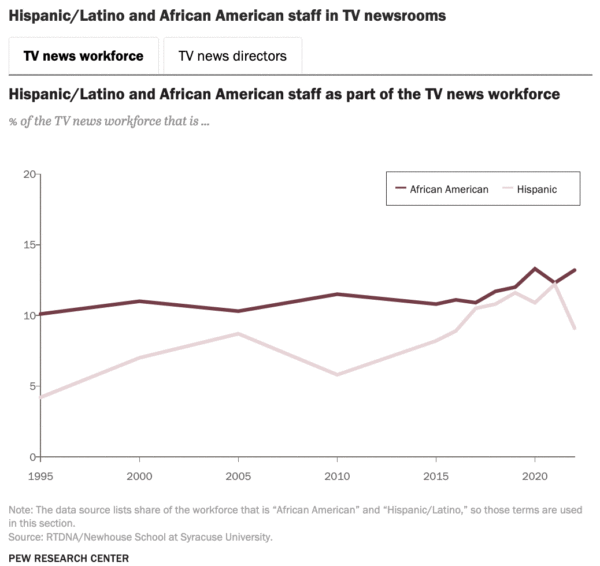Hispanic and Black News Media Fact Sheet
August 3, 2023

News media made by and for the two largest racial and ethnic minority groups in the United States – Black Americans and Hispanic Americans – have been a consistent part of the American news landscape. Largely, newspapers and television aimed at both of these groups have recently had audience declines. Explore the trends in Hispanic- and Black-oriented news outlets below.
Pew Research Center is not aware of any current directory with publicly available representative data for news media companies oriented toward Asian American audiences and is therefore unable to produce audience or economic analyses for Asian American-oriented news outlets at this time.
Audience
The two largest Spanish-language television networks in the United States, Univision and Telemundo, are key providers of news for Spanish speakers. Both networks had declines in viewership.
Univision’s average audience – measured as the average number of TVs tuned to a program throughout a period of time – declined in 2022 for all three national time slots studied. This was an 11% decline for the evening news time slot, from an average audience of about 804,000 to roughly 714,000; a 16% decline in late night news; and a 7% decline for the morning news time slot.
Telemundo’s audience also dropped in 2022 – by 9% in the evening news time slot, from 479,000 to 435,000; and by 16% in the late night news time slot. These declines continued a pattern that started for many time slots in 2021.
Audience for Univision network
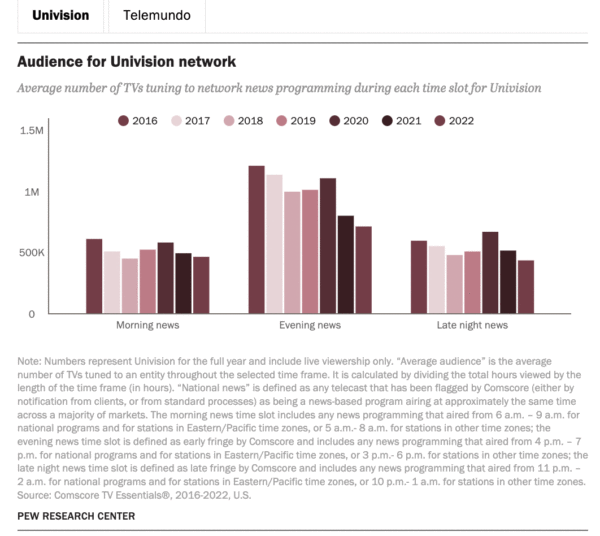
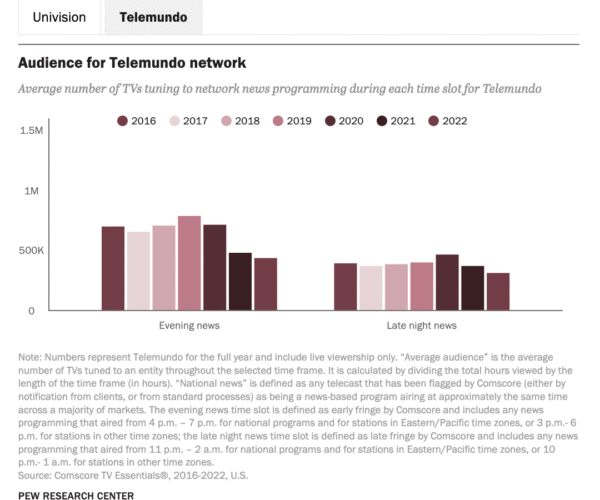
Both Univision and Telemundo have local affiliate stations that carry their own original news programming. In 2022, average viewership for Univision affiliates increased for morning news but decreased in the two later time slots. Univision affiliates’ morning news showed an increase of 17%, while evening news viewership for Univision affiliates declined by 7% and late night news viewership declined by 8%.
Average viewership for Telemundo affiliates during these time slots all increased or stayed roughly the same, with morning news increasing by 28%, late night news viewership increasing by 5%, and evening news audiences remaining about steady.
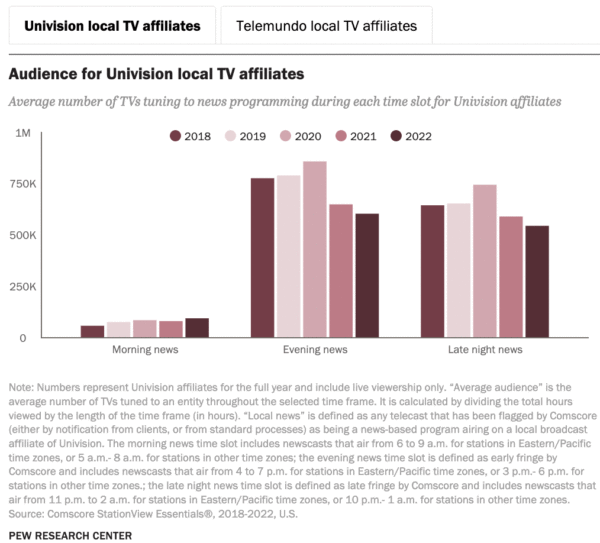
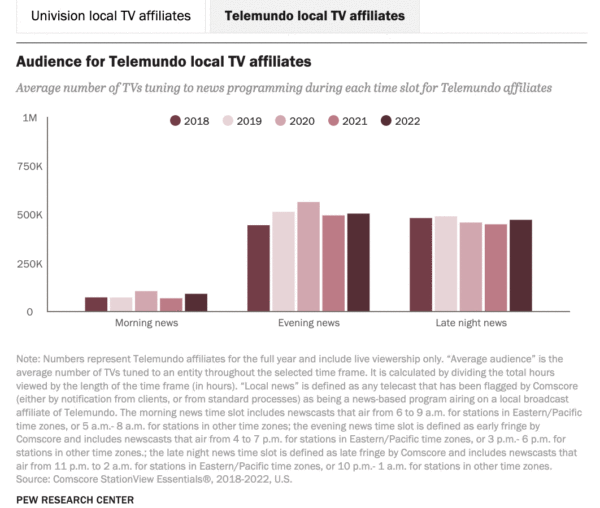
Circulation for Hispanic newspapers
Since 2015, to get a summary measure of circulation at weekly and semiweekly Hispanic newspapers, the Center has used an average of the top 20 of these newspapers that report current and historical data to the Alliance for Audited Media – the Center’s main source for newspaper circulation data.
Beginning in 2021, there were no longer 20 Hispanic newspapers that reported their circulation to our data sources. This may be due to a combination of factors – including, in some cases, larger English-language newspapers no longer breaking out their affiliated Spanish-language publications in their circulation reports (for example, the Fort Worth Star-Telegram’s circulation reports no longer break out the affiliated publication La Estrella). Other newspapers still appear to publish, but their circulation is no longer reported or available in the Alliance for Audited Media’s database.
In 2021, there were only 18 weekly or semiweekly Hispanic newspapers with circulation data available to Pew Research Center. That figure dropped to 11 in 2022. For those papers available, average per-paper circulation declined, though that may be an artifact of a few larger newspapers dropping out of the data. Average circulation for the Hispanic weeklies with data available dropped over the past three years, from roughly 109,000 in 2020 to about 92,000 in 2021, to about 83,000 for the 11 papers that reported circulation in 2022.
For the only daily Hispanic newspaper for which there is 2022 data – El Nuevo Herald in Miami – circulation also declined.
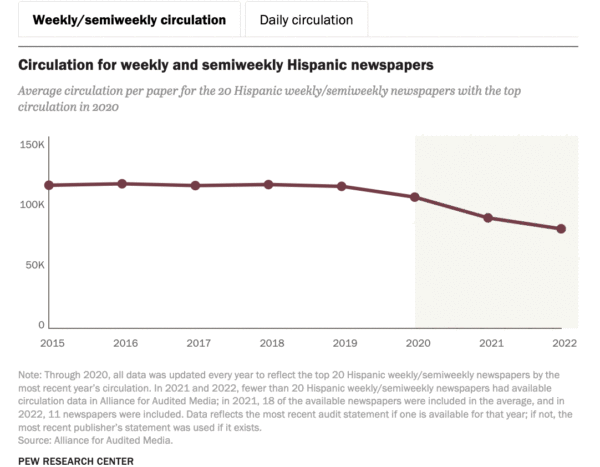

Circulation for Black-oriented newspapers
Black-oriented newspapers are a long-standing minority news sector in the U.S. The Center for Community Media at the CUNY School of Journalism’s Mapping Black Media Project lists 200 newspapers as being owned by or oriented toward Black Americans. But few of those newspapers, or of those listed as members of the National Newspaper Publishers Association (the Black Press trade association), have regularly audited circulation figures. This makes it difficult to acquire audience figures for the sector as a whole.
Fourteen Black-oriented newspapers have recently reported circulation data. Among the eight papers with data for both 2022 and 2021, two had increases in circulation, and none saw their circulation drop by more than 10%. However, there are a number of newspapers whose circulation is no longer available, including the Baltimore and Washington Afro-American, founded in 1892, the Michigan Chronicle, founded in 1936, and the Dallas Weekly, founded in 1954. This decline in reported weekly and semiweekly newspaper circulation reflects the problems with data collection we’ve seen among Hispanic newspapers in the U.S.
The Mapping Black Media Project lists 48 radio stations and station networks from 23 different states that are owned by or oriented toward Black Americans. It also lists three television stations: KSQA in Kansas, WHPR in Michigan and WHUT in Washington, D.C. Pew Research Center does not have access to enough adequate financial data for these radio and television stations at this time to serve as a quality representation of the state of Black-oriented stations in the U.S.
In the absence of abundant audience or financial data, survey data can shine some light on how Black Americans engage with the news. Black Americans are more likely than others to prefer to get their news on television, and are more likely than any other racial or ethnic group to follow local news very closely.
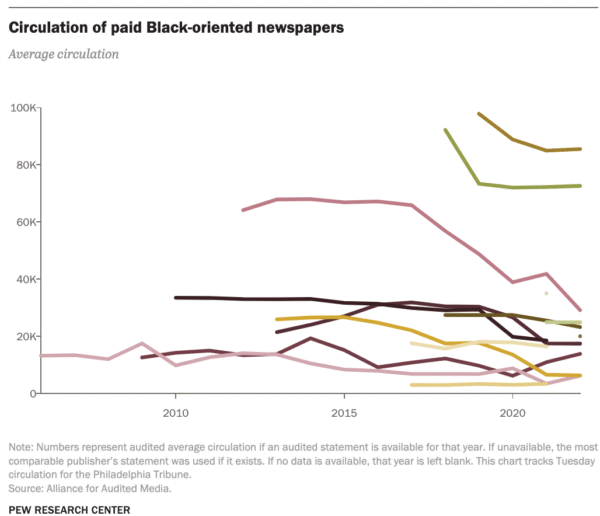
Economics
U.S. media company TelevisaUnivision, formed from a merger of Mexico’s Grupo Televisa and Univision in early 2022, reported to the Securities and Exchange Commission a total revenue of $4.6 billion in 2022. This is significantly higher than the company’s revenue of $2.8 billion in 2021, which includes figures from before and after the merger. (Telemundo’s revenue is not available for analysis, as its parent company, Comcast, does not provide network-specific revenue.)
Revenue for TelevisaUnivision

While audience data is not available for Spanish-language news radio, revenue data is available. Average station revenue for Spanish-language news stations that are listed in the BIA Advisory Services database has largely recovered from declines in revenue in 2020.
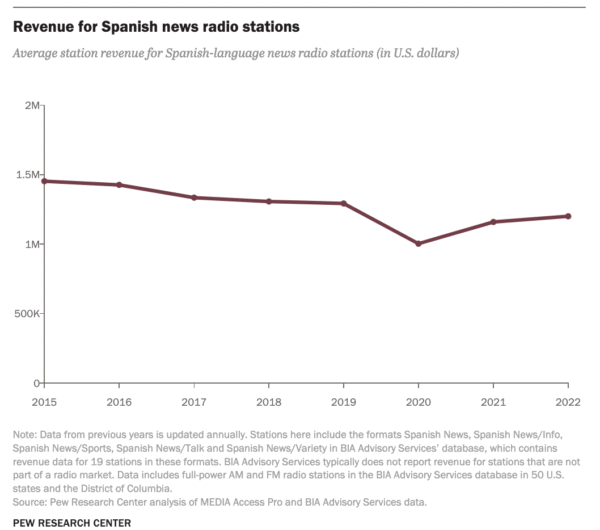
There is no revenue data available for Black-oriented newspapers, which are mostly privately held, and no database that the Center is aware of separates out Black-oriented TV or radio news stations from all English-speaking news outlets.
Newsroom investment
The portion of local TV newsroom staff who are African American is at 13.2% in 2022, now remaining roughly steady between around 12% and 13% since 2018, according to a survey of TV stations from RTDNA/Newhouse School at Syracuse University. By comparison, the percentage of television news directors who are African American is smaller, at just 6%. In 2022, 9% of the TV news workforce and 7% of TV news directors are Hispanic/Latino, both declines from 2021.
Hispanic/Latino and African American staff in TV newsrooms
